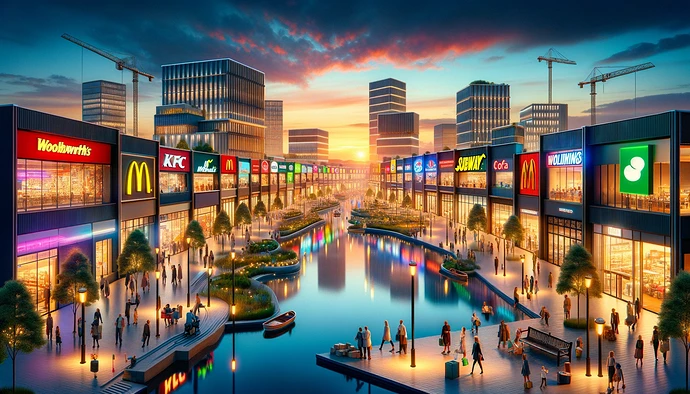New Store Openings
New Store Openings
Important
This video is from the past, but it covers key metrics that help explain market trends and their effect on property prices.
Here, you will explore the factors influencing capital growth, emphasising the strategic expansion of retail giants as key indicators. It suggests that companies like McDonald’s, KFC, Subway, Woolworths, Coles, and Bunnings in a particular area signify researched potential growth. Retail expansions are viewed as indicators of area development, offering insights into market research conducted by these corporations.
The video advises monitoring new store openings as a strategy for identifying growth areas, using examples such as Bunnings creating jobs in West Ipswich and Coles’ plan to open 70 new stores.
Additionally, it touches on lifestyle factors like proximity to water bodies and entertainment centres as constants in capital growth. It concludes with the “black sheep effect,” highlighting the potential in the suburbs previously stigmatised for various reasons, suggesting that improvements in safety and infrastructure can lead to significant growth.
Insights based on numbers
- Retail Giants: Presence in an area is a researched indicator of growth.
- 70 New Stores: Coles’ expansion plan signals significant development.
- 8200 Construction Jobs: Reflects the scale of development and economic impact.
Frequently Asked Questions
What is the impact of lifestyle factors on capital growth?
Lifestyle factors are crucial in determining capital growth, particularly within the real estate sector. Properties situated near natural attractions, such as coastlines and water bodies, or amenities like golf courses and entertainment centres, are in high demand.
The appeal of these areas is not just their beauty or entertainment value but also their scarcity. As such locations are limited in availability, they experience sustained capital growth over time.
Investing in properties near these attractions is considered a strategic move for long-term value appreciation. The demand for living environments that offer quality and proximity to nature or leisure facilities is continually increasing.
How does the “black sheep effect” influence real estate investment decisions?
The “black sheep effect” refers to areas once marred by negative reputations, such as high crime rates or other detracting factors, but now showing signs of positive change and thus potential for capital growth.
Factors contributing to this turnaround could include government intervention, enhanced safety measures, or declining crime rates.
Investors are advised to monitor these neighbourhoods closely, as the shedding of their negative image and improvements in safety and infrastructure can lead to rapid increases in property values.
This phenomenon highlights the importance of assessing the future potential of an area based on concrete improvements and efforts towards community development rather than solely its past reputation.
What are the strategies for identifying areas with potential capital growth?
Identifying areas with potential capital growth involves several strategies focusing on market research and observable development indicators. One effective approach is to monitor the expansion decisions of major retail giants.
Companies like McDonald’s, KFC, Subway, Woolworths, Coles, and Bunnings conduct extensive market research before opening new stores, so their new locations often signal an area’s economic growth and desirability.
Regularly searching for announcements about new store openings can also provide insights into which areas are poised for growth. Specific searches related to these openings can help gather information on future developments and indicate areas where these corporations see potential.
Additionally, considering lifestyle factors is crucial. Properties near natural attractions, such as coastlines, water bodies, or amenities like golf courses and entertainment centers, are in high demand. These locations are sought after due to their inherent appeal and limited availability, making them strategic choices for long-term value appreciation.
Another strategy involves paying attention to areas that are improving from previously negative reputations due to factors such as government intervention, improved safety measures, or declining crime rates. These neighbourhoods, once considered “black sheep” due to various stigmas, might offer significant growth potential as they transform and attract more interest.
What does the presence of retail giants indicate about an area?
The presence of major retail chains such as McDonald’s, KFC, Subway, Woolworths, Coles, and Bunnings in a specific area is a researched indicator of potential growth. These corporations conduct extensive market research before deciding on new locations, implying that their expansion into an area signals confidence in its development prospects.
How can new store openings by retail giants be used to identify growth areas?
Monitoring new store openings is a strategic approach to identifying areas likely to experience growth. Retail giants decide to open new stores based on thorough research and analysis, indicating a forecast of economic development, population growth, or increased consumer demand in those areas.
What impact does the opening of new stores have on employment?
The construction and operation of new retail stores, such as the example of Bunnings creating jobs in West Ipswich, generate employment opportunities. The video highlights that such expansions can create 8,200 construction jobs, reflecting the scale of development and the economic impact on the local workforce and community.
How do lifestyle factors influence capital growth?
Lifestyle factors, including the proximity to water bodies and entertainment centres, are constants in capital growth. Areas that offer desirable lifestyle features tend to attract more residents and visitors, supporting retail and economic development. These factors make such locations more attractive for retail giants looking for new store locations.
Why are retail expansions viewed as indicators of area development?
Retail expansions are considered indicators of area development because they offer insights into the market research and forecasts conducted by large corporations. These companies invest significant resources in analysing consumer behaviour, economic trends, and demographic shifts before opening new stores. Therefore, their expansion activities signal confidence in the area’s potential for growth and development.
Test Your Knowledge!
Assignment
Analysing the Impact of Retail Giants on Local Economies and Real Estate
Objective:
This assignment aims to enhance your understanding of how the strategic expansion of retail giants can serve as key indicators of potential capital growth in specific areas. By examining factors such as the presence of large retailers, lifestyle amenities, and the “black sheep effect,” you will develop insights into the dynamics of real estate investment and economic development.
Instructions:
Research and Analysis:
To Do: Identify a locality that has recently experienced the opening of new stores by retail giants like McDonald’s, KFC, Subway, Woolworths, Coles, or Bunnings.
Research Question: How did the opening of these stores impact the local economy and real estate market in terms of employment opportunities, property values, and overall economic growth?
Case Study: Bunnings and Coles Expansion
To Do: Conduct a case study on Bunnings creating jobs in West Ipswich and Coles’ plan to open 70 new stores. Examine the projected and actual impacts of these expansions.
Research Question: What were the expected outcomes of these expansions, and how do they compare to the actual results in terms of job creation, local economic development, and real estate values?
Lifestyle Factors and Capital Growth:
To Do: Select a real estate property near a natural attraction or an entertainment centre. Analyse how its value has changed over time compared to properties in less desirable locations.
Research Question: What role do lifestyle factors play in determining the capital growth of properties in these areas?
The Black Sheep Effect:
To Do: Find an example of a suburb that was once considered a “black sheep” but has recently shown signs of positive change. Investigate the factors contributing to its turnaround.
Research Question: How has the shedding of its negative image and improvements in safety and infrastructure affected property values and investor interest in the area?
Strategies for Identifying Growth Areas:
To Do: Develop a strategy for identifying other areas with potential capital growth using the concepts learned from the article.
Research Question: What indicators would you look for, and how would you apply the insights gained from the retail expansions and lifestyle factors to make informed investment decisions?
Deliverables:
- A detailed report including the findings from your research and analysis, case studies, and developed strategies.
- Comparative data charts or tables illustrate retail expansions’ impact on local economies and real estate values.
- A presentation summarising your key findings, insights, and recommendations for real estate investors.
Assessment Criteria:
- Depth of research and analysis on the impact of retail giants on local economies and real estate markets.
- The relevance and applicability of identified lifestyle factors and the “black sheep effect” on capital growth.
- Creativity and feasibility of the strategies developed for identifying areas with potential capital growth.
- Clarity, organisation, and presentation of findings and recommendations.
This assignment will not only deepen your understanding of the interplay between retail expansions and real estate development but also equip you with practical tools and strategies for identifying promising investment opportunities.


